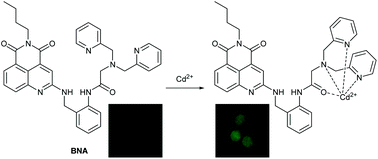A 4,5-quinolimide-based fluorescent sensor for the turn-on detection of Cd2+ with live-cell imaging†
Abstract
A 4,5-quinolimide derivative, BNA, bearing the amide-DPA receptor, was synthesized as a turn-on fluorescent sensor for Cd2+. Under physiological conditions, BNA could distinguish Cd2+ from Zn2+, showing turn-on fluorescence behaviour and an increased fluorescence lifetime. BNA and Cd2+ formed a 1 : 1 stoichiometric complex, and the detection limit was measured to be as low as 11 nM. Furthermore, BNA was utilized for fluorescence imaging of Cd2+ in live cells. To the best of our knowledge, it is the first 4,5-quinolimide-based sensor for the detection of metal ions.



 Please wait while we load your content...
Please wait while we load your content...